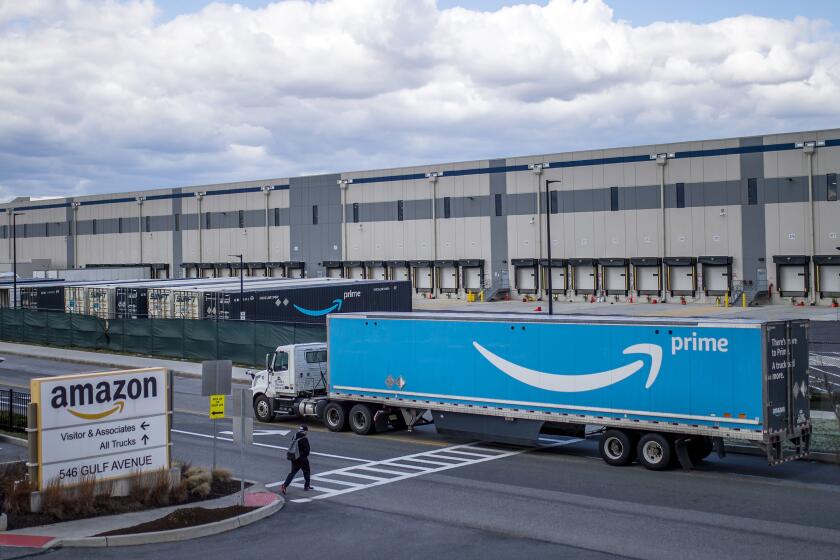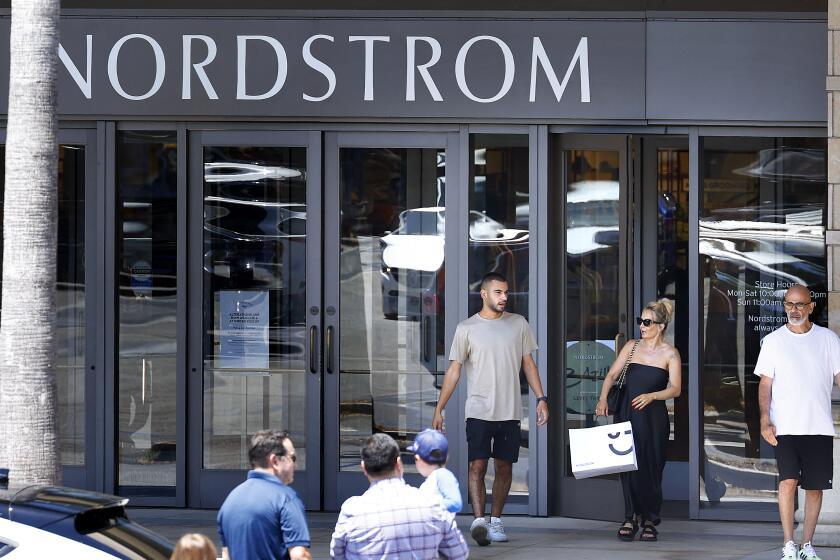Getting a break at the pump
- Share via
Oil prices coughed up all of their 2008 gains and then some Thursday, stopping only after crashing below the $70-a-barrel barrier, a level not seen since the summer of 2007.
The betting money is that oil still has much further to fall, perhaps as low as $50 a barrel before the end of the year.
Economists say that would give beleaguered U.S. consumers the rough equivalent of a new economic stimulus package, dragging retail gasoline prices back down as low as $2.20 a gallon nationally. Natural gas and heating oil prices also are cratering, which would help with winter heating bills.
One possible hitch comes from OPEC, which Thursday called for an emergency meeting next week to discuss whether to cut production. Ministers from the Organization of the Petroleum Exporting Countries, which pumps more than 40% of the world’s oil, had planned to meet after the U.S. election but now will gather in Vienna on Oct. 24.
“OPEC will try to get prices to stabilize around $70, but $70 oil is still not cheap with global economies slowing and demand running this low,” said Fadel Gheit, senior energy analyst for Oppenheimer & Co.
In New York futures trading, the U.S. benchmark grade of oil fell to $68.57 a barrel before closing at $69.85, down $4.69. It was the lowest settlement price since Aug. 23, 2007.
Oil has declined more than 50% from the record high in July above $147, largely on fears that slumping world economies would further damp use of oil and its products.
Traders said the market reacted negatively to an Energy Department report Thursday that U.S. oil and gasoline stockpiles were sharply higher than expected and gasoline demand was down 5.2%. Phil Flynn, senior market analyst for Alaron Trading Co., said traders were still trying to catch their breath by the end of the day.
“Now you know why some of us drink heavily,” Flynn quipped, noting that he had begun the day thinking that oil could drop to $67 a barrel but ended it believing that $50 was possible by year’s end.
Pump prices continued to plunge. The average price for a gallon of self-serve regular Thursday was $3.084 nationwide, down 4.1 cents from Wednesday, according to AAA. In California, the average fell 2.2 cents to $3.42. Analysts predicted the U.S. average could drop to $2.20 to $2.50 a gallon nationally and $2.70 to $3 in California by New Year’s Day.
“We’re dropping like a rock today,” said Tom Kloza, chief oil analyst for the Oil Price Information Service. “We are on a rendezvous with lower prices across the country.”
But economists aren’t optimistic about what consumers would do with the money they figured to save. With retirement accounts battered, home values hurting and confidence bruised, Americans are more likely to catch up on their bills and savings at a time when the economy needs them to go out and shop, some experts say.
“More than 70% of the U.S. economy is consumer spending, and the real risk going forward is that they won’t spend,” said Edward E. Leamer, director of the UCLA Anderson Forecast. “Take your wife or your husband out for a nice meal at a restaurant. Buy a pair of shoes, the kind of normal things we used to do.”
Motorists say they aren’t feeling any of that old love for conspicuous consumption.
Lisette Mata, 21, a customer service representative for a check-cashing business, was pumping gas at a West Hollywood Chevron as a worker updated the station’s price sign. When the price for regular changed from to $3.43 a gallon from $3.49, she looked disgusted.
“What would I do with the money? I’d pay bills, buy groceries. I can’t afford anything else right now,” Mata said.
Abel Sahid, 49, was taking a break from a nearby plumbing job, buying a bottle of water at a Chevron in downtown Los Angeles. His biggest hope for lower gas prices was that more people might be able to afford to hire him.
“It would be much better for everyone, but I think I would save the money. Most of my savings are gone,” Sahid said.
Traditionally, lower fuel prices lead consumers to drive more and to buy larger, less fuel-efficient vehicles. That was the effect of an oil price drop in 1980, which, experts say, ultimately led to the advent of sport utility vehicles. But that may not be the case this time around, said Mary Novak, analyst at Global Insight.
“It took a pretty long period of high oil prices to convince people not to buy SUVs,” she said. “It’ll take a while, too, for them to be convinced by low prices to start to buy them again.”
Should oil prices stay low, it could reduce pressure on automakers’ programs to develop fuel-efficient cars. General Motors Corp., Toyota Motor Corp. and Chrysler all ramped up development of hybrids, plug-in hybrids and electric cars in the face of $4-plus gas. And though the carmakers need fuel-efficient cars to comply with strict new mileage rules, if gas prices are too low, such products may not appeal to consumers.
But Robert Peterson, spokesman for GM’s alternative-vehicle programs, said the company would go ahead with its electric and hybrid car programs. “There’s a lot more to this than just the price of oil,” he said.
Although consumers might be slow to respond to lower energy prices, business is likely to be a much more eager participant.
Lower oil prices will help any business dependent on the internal combustion engine, said Joe Stanislaw, independent senior advisor for consulting firm Deloitte. He cites taxis, limousine services and pizza delivery companies as examples.
“This is like a big tax cut to those businesses,” said Stanislaw, who added that with fuel expenses down, firms could begin to cut those fuel surcharges or even lower prices.
Another possible boon to consumers and the economy is the sharp decline in natural gas prices. In July, natural gas futures hit a peak of $13.57 per million British thermal units, a common measurement for large natural gas trades. On Thursday, natural gas closed at $6.70 per million BTUs, a decline of more than 50%.
That will save a lot of people money, Global Insight’s Novak said. In regions such as California, where a lot of power generation comes from natural gas, she said, “electricity prices will be coming down and could very well be lower than they were a year ago.”
--
ken.bensinger@latimes.com
More to Read
Inside the business of entertainment
The Wide Shot brings you news, analysis and insights on everything from streaming wars to production — and what it all means for the future.
You may occasionally receive promotional content from the Los Angeles Times.











